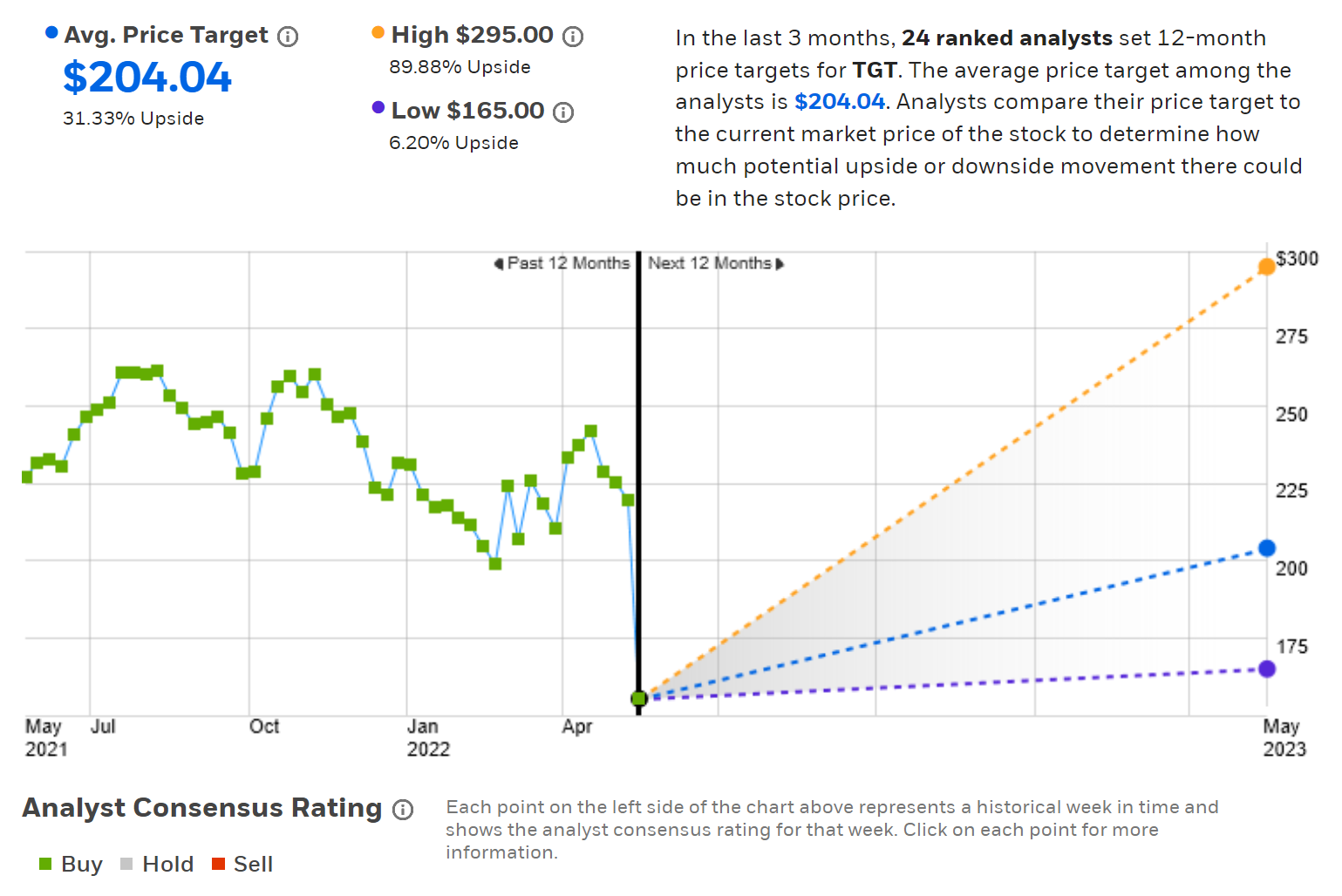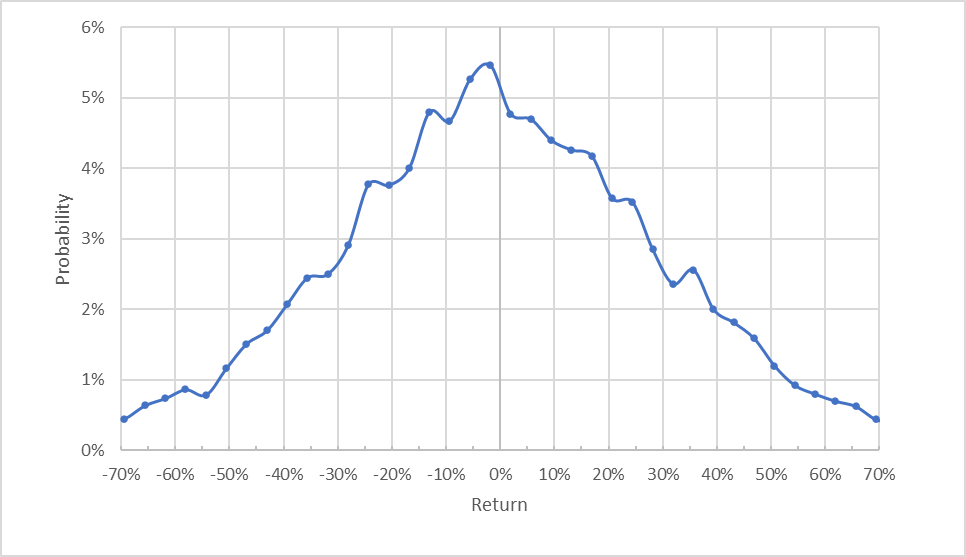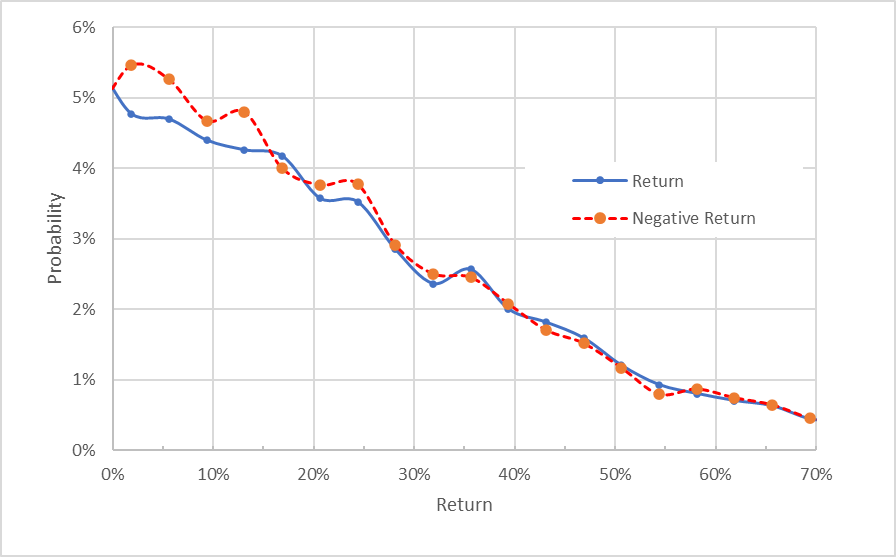- Target shares slumped 25% after disappointing Q1 results
- Prevailing view among analysts is that the sell-off is an overreaction
- The Wall Street consensus rating is bullish, as it has been for all of the past year
- The market-implied outlook is neutral to slightly bullish to early 2023
-
For tools, data, and content to help you make better investing decisions, try InvestingPro+
- How long the inflation-driven spike in costs will persist
- How much of the earnings growth from the past 2 years will be sustainable
Target (NYSE:TGT) reported Q1 results before the market opened on Mar. 18, substantially missing expectations. Shares of the retail giant subsequently fell 25% on that day. The total return for TGT is now around -30% over the past 12 months.
However, despite the recent slump, Target's trailing 3-year total return still stands around 27% per year, which is incredibly high for a department store. For context, this is a much higher annualized return than the NASDAQ (QQQ), which had a 3-year annualized return of around 18% per year over the same period.

Source: Investing.com
The discount retailer had consistently beaten earnings expectations for every quarter except one over the past four years prior to the latest Q1 results. Quarterly EPS for Q1 was 29% below the expected value. Looking at the historical earnings chart provides important insight. Quarterly EPS jumped substantially in mid-2020 and remained extremely high compared to recent years for the subsequent quarters. The recently-reported Q1 earnings, while below those for any quarter since mid-2020, were higher than in any quarter in 2019.
Source: E-Trade. Green (red) values are amounts by which EPS beat (missed) the consensus expected value.
The earnings history shows that the Minneapolis headquartered general retailer enjoyed a surge in earnings during COVID, largely attributable to consumers spending more on home goods, Target’s growing success in e-commerce, and the boost to spending from stimulus payments and enhanced unemployment benefits. The consensus earnings outlook suggests that a considerable amount of the growth over the past two years will persist.
In the earnings call following the Q1 results, management attributed the drop in earnings to inflationary pressures, including much higher freight costs and supply chain constraints, as well as the substantial decline in purchases of home-related goods (specifically citing kitchen appliances, TVs, and outdoor furniture). The company was caught with a substantial oversupply in these types of goods, resulting in costs to store this inventory as well as to shift to focus on items in current high demand.
It is also important to note that TGT’s valuation climbed during the pandemic as consumer spending rose. The P/E was above 20 during part of 2021 and, indeed, had been rising rapidly since 2018 as TGT grew its e-commerce presence and investors responded by bidding up the shares. At the current price, the P/E is 12.9, and the forward P/E is 14.7.
The key questions for investors are:
In forming an opinion on TGT, I rely on two forms of consensus outlooks. The first is the Wall Street analyst consensus rating and price target. The second is the market-implied outlook, representing the consensus among buyers and sellers of options.
A brief explanation could help readers unfamiliar with the market-implied outlook. The price of an option on a stock reflects the market’s consensus estimate of the probability that the stock price will rise above (call option) or fall below (put option) a specific level (the option strike price) between now and when the option expires. By analyzing the prices of call and putting options at a range of strike prices, all with the same expiration date, it is possible to calculate a probabilistic price forecast that reconciles all of the option prices. This is the market-implied outlook. For more information than is provided here and in the previous link, I recommend this monograph published by the CFA Institute.
I have calculated the market-implied outlook to early 2023 and compared this with the current Wall Street analyst consensus, along with considering the fundamentals in assigning a rating for TGT.
Wall Street Consensus Outlook For TGT
E-Trade calculates the Wall Street consensus outlook for TGT based on ratings and price targets from 24 ranked analysts who have published opinions over the past 90 days. Readers may question how relevant any pre-earnings view may be given the recent earnings announcement.
The consensus rating on TGT is bullish, and the consensus 12-month price target is $204, 31.3% above the current share price. All 24 analysts included in this consensus updated or reiterated their views on May 18 and 19. It is notable, however, that none of the analysts used to form the consensus in recent months have had a sell rating on the stock. Following the sell-off, several analysts have suggested that the drop in share price is an overreaction.

Source: E-Trade
Investing.com calculates the Wall Street consensus outlook based on ratings and price targets from 31 analysts. The consensus rating is bullish and the consensus 12-month price target is $206, very close to the result from E-Trade.

Source: Investing.com
The Wall Street analyst consensus rating is bullish, with a 12-month price target that is about 30% above the current share price. There are, however, two concerns with this consensus view. First, none of the analysts anticipated any issues coming up to Q1 earnings. The E-Trade consensus rating has been bullish for all of the past 12 months and no analysts in the E-Trade cohort had assigned a rating below hold in recent months. The second concern is that there is a wide spread in the individual price targets that go into the consensus. Research has found that the predictive value of the consensus falls as the dispersion among the price targets increases.
Market-Implied Outlook For TGT
I have calculated the market-implied outlook for TGT for the 7.9-month period from now until Jan. 20, 2023, using the prices of call and put options that expire on this date. I selected this specific expiration date to provide a view through the end of 2022 and because the options that expire in January tend to be among the most traded, adding confidence in the meaningfulness of the outlook.
The standard presentation of the market-implied outlook is a probability distribution of price return, with probability on the vertical axis and return on the horizontal.

Source: Author’s calculations using options quotes from E-Trade
The outlook for January is generally symmetric, with similar probabilities for positive and negative returns of the same size. The expected volatility calculated from this outlook is 40% (annualized), which is high for a large retailer but seems reasonable given the recent massive drop in the share price.
To make it easier to compare the probabilities of positive and negative returns, I rotate the negative return side of the distribution about the vertical axis (see chart below).
Source: Author’s calculations using options quotes from E-Trade. The negative return side of the distribution has been rotated about the vertical axis.
This view shows that the probabilities of positive and negative returns are remarkably similar (the solid blue line and the dashed red line are close to one another). However, there is a slightly elevated probability of negative returns for outcomes in the range of +/-15% return over the next 8 months.
Theory indicates that the market-implied outlook is expected to have a negative bias because investors, in aggregate, are risk-averse and thus tend to pay more than the fair value for downside protection (e.g. put options). There is no way to directly measure whether this effect is present, however. Considering the expectation for a negative bias, this outlook is best interpreted as neutral or even slightly bullish.
Summary
The recent slide in Target's share price begs the question of whether the shares have been oversold. The prevailing view among Wall Street analysts is that the selloff is an overreaction and that the shares are now undervalued. The consensus rating is bullish, as it has been for all of the past year, and the consensus 12-month price target is about 35% above the current share price. The market-implied outlook for TGT is neutral to slightly bullish, with expected volatility of 40% (annualized).
As a rule of thumb for a buy rating, I want to see an expected 12-month total return that is at least half the expected annualized volatility. Taking the analyst consensus price target at face value and adding the dividend, TGT is well above this threshold.
That said, none of the analysts anticipated the recent earnings shock as there were no sell ratings just prior to Q1 earnings. Considering the improved (lower) valuation, the bullish Wall Street outlook, and the neutral / slightly bullish market-implied outlook, I am cautiously optimistic, so I am assigning a buy/bullish rating.
***
Interested in finding your next great idea? InvestingPro+ gives you the chance to screen through 135K+ stocks to find the fastest growing or most undervalued stocks in the world, with professional data, tools, and insights. Learn More »
